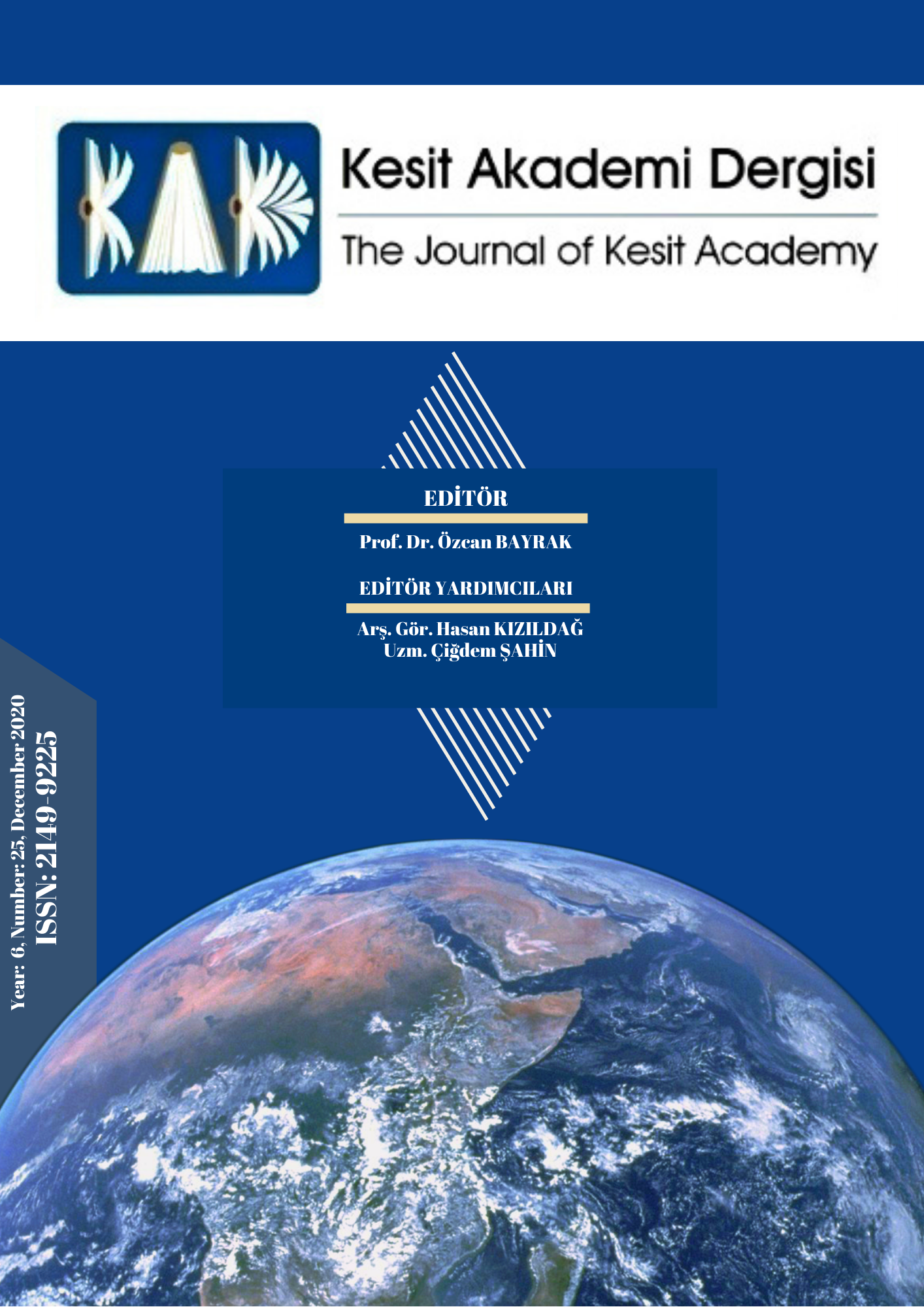Author :
Abstract
Bu araştırmada Türkiye’de cam tavan üzerine alanyazındaki eğilimleri ve eksik bırakılan kısımları belirlemek, yeni sonuçlara ulaşabilmek amacıyla, ilgili alandaki lisansüstü tezlerin bir meta-değerlendirmesi yapılmıştır. Yükseköğretim Kurulu Ulusal Tez Merkezi veri tabanından ulaşılabilen lisansüstü tezler (f=98) yıllara, türüne, yöntemine, alanına, örneklem/çalışma birimi niteliklerine ve cinsiyetine, örneklemin alındığı illere, araştırmacı ve danışman cinsiyetine, veri toplama araçlarına, ulaşılan sonuçlara göre sınıflandırılarak analiz edilmiştir. Araştırma sonuçlarına göre; çalışmaların sayısı son üç yılda giderek artmıştır, doktora tezleri kritik seviyede kalmıştır; en fazla nicel yöntem, ölçek tercih edilmiş, çalışmalar en çok büyük şehirlerde işletme alanında özel sektör çalışan ve yöneticileriyle yapılmıştır; kadın araştırmacılar ilgili konuya hem yüksek lisans hem de doktora düzeyinde daha fazla ilgi göstermiştir, yüksek lisans tezi çalışmalarında erkek danışmanlar çoğunluktadır, doktora çalışmalarında ise danışmanların tamamı erkektir. İncelenen çalışmalardan ulaşılan sonuçlara göre cam tavanın nedenleri ve sonuçları bireysel etmenler ve çevresel etmenler olarak iki ana kategoride sunulmuştur.
Keywords
Abstract
The aim of this study is to examine postgraduate theses in Turkey on glass ceiling through meta-evaluation. Accessible theses (f=98) on the database of the National Dissertation Center of The Council of Higher Education were evaluated in terms of publication year, type, method, field of the studies, qualifications and gender of the sample unit, provinces of samples, gender of researcher and advisor, data collection tool and results. Results show that the number of studies has increased in the last three years. Doctoral theses remained at a critical level. Quantitative method as model, private sector employees and managers as sample group, metropolitan cities as sample of city, scale as data collection tool were preferred in the vast majority of the studies. Female researchers showed more interest in the relevant subject at both levels, male advisors were the majority in master's theses, while all advisors were male in doctoral theses. The causes and results of glass ceiling can be expressed in two main categories as individual and environmental factors based on the results.
Keywords
- Akdöl, B. (2009). Cam tavan ve kurumsal bir strateji pozitif ayrımcılık; ilaç sektöründe bir sınıf-
- Ararat, M., Alkan, S., & Aytekin, B. (2019). 7th Annual Report, Women on Board Turkey. Erişim adresi: http://research.sabanciuniv.edu/39456/ (28 Ağustos 2020)
- Bierema, L. L., & Merriam, S. B. (2002). E-mentoring: Using computer mediated communication to enhance the mentoring process. Innovative Higher Education, 26(3), 211-227.
- Büyüköztürk, Ş., Çakmak, E. K., Akgün, Ö. E., Karadeniz, Ş., & Demirel, F. (2017). Bilimsel araş- tırma yöntemleri. Ankara: Pegem Akademi.
- Clerkin, C. (2017). What Women Want--And Why You Want Women--In the Workplace. Rese- arch Report. Erişim adresi: https://eric.ed.gov/?id=ED582896 (20 Ağustos 2020).
- Clutterbuck, D. (2014). Everyone needs a mentor. London: The Chartered Institute of Personnel and Development.
- Coscieme, L., Fioramonti, L., Mortensen, L. F., Pickett, K. E., Kubiszewski, I., Lovins, H., vd. (2020). Women in power: Female leadership and public health outcomes during the COVID-19 pandemic. Erişim adresi: https://www.medrxiv.org/content/10.1101/2020.07.13.20152397v2.full.pdf (21 Ağustos 2020).
- Davidson, M. J., & Cooper, C. L. (1992). Shattering the glass ceiling: The woman manager. England: Paul Chapman Publishing.
- Devillard, S., Hunt, V., & Yee, L. (2018). Still looking for room at the top: Ten years of research on women in the workplace. McKinsey Quarterly, 2, 106-115.
- Dezsö, C. L., & Ross, D. G. (2012). Does female representation in top management improve firm performance? A panel data investigation. Strategic management journal, 33(9), 1072-1089.
- Emelianova, O., Milhomem; C. (2019). Women on boards 2019 Progress Report. Erişim adresi: https://www.msci.com/documents/10199/29f5bf79-cf87-71a5-ac26-b435d3b6fc08 (31 Ağustos 2020)
- Güven, S., Uçar, M. (2019). ‚Kariyer Engelleri: Cam Tavan‟‟ Konusuna İlişkin 2009-2019 Yılları Arasında Yapılan Tezlerin İncelenmesi. 14. Uluslararası Eğitim Yönetimi Kongresi Tam Metin Bildiri Kitabı (s. 100-108).
- Hofstede, G. (1984). Cultural dimensions in management and planning. Asia Pacific Journal of Management, 1(2), 81–99. doi:10.1007/bf01733682
- Huang, J., Krivkovich, A., Starikova, I., Yee, L., & Zanoschi, D. (2019). Women in the Workplace 2019. Erişim adresi: https://www.mckinsey.com/~/media/McKinsey/Featured%20Insights/Gender%20Equali ty/Women%20in%20the%20Workplace%202019/Women-in-the-workplace-2019.pdf (25 Ağustos 2020).
- ILO (2019). Women in Business and Management: A global survey of enterprises. Erişim adresi: ilo.org/wcmsp5/groups/public/---dgreports/---dcomm/--publ/documents/publication/wcms_702196.pdf (02 Ekim 2020)
- Kafes, M. (2019). Türkiye’de Kadınların Maruz Kaldığı Cam Tavan Davranışı Üzerine Sağlık Kurumlarında Yapılmış Çalışmaların Bir İncelemesi. Necmettin Erbakan Üniversitesi Sağlık Bilimleri Fakültesi Dergisi, 2(1), 25-30.
- Lyngsie, J., & Foss, N. J. (2016). The more, the merrier? Women in top-management teams and entrepreneurship in established firms. Strategic Management Journal, 38(3), 487–505.
- Mayring, P. (2004). Qualitative content analysis. A companion to qualitative research, 1(2), 159-176.
- Mertz, N. T. (2004). What’s a Mentor, Anyway? Educational Administration Quarterly, 40(4), 541– 560.
- O’Grady, S. (2019). ‘’The G-20 talks about ways to empower women. But only two member countries are run by women.’’. Washingtonpost. Erişim adresi: https://www.washingtonpost.com/world/2019/06/29/g-talks-about-ways-empowerwomen-only-two-member-countries-are-run-by-women/ (1 Eylül 2020).
- Osuoha, R. (2010). A Study of African American Women: The Impact of the Glass Ceiling Syn- drome on Advancement Opportunities in Organizations. Dissertation Abstracts International, 71(04).
- Ragins, B. R., Townsend, B., & Mattis, M. (1998). Gender Gap in the Executive Suite: Ceos and Female Executives Report on Breaking the Glass Ceiling. Academy of Management Perspectives, 12(1), 28–42.
- Scriven, M. (2009). Meta-evaluation revisited. Journal of multidisciplinary evaluation, 6(11), 3-8.
- Sneader, K.& Yee, L. (2019). One is the loneliest number. McKinsey Quarterly. Erişim adresi: https://www.mckinsey.com/featured-insights/gender-equality/one-is-the-loneliestnumber# (28 Ağustos 2020).
- Stufflebeam, D. L. (1974). Meta- Evalution. Journal Of Multidisciplinary Evolution. (7)15, 99-158.
- Stufflebeam, D. L. (1978). Meta Evaluation: An Overview. Evaluation & the Health Professions, 1(1), 17–43.
- Üçyıldız, H. U. (2017). Kadın çalışanların cam tavan sendromu algılamaları: Ege Bölgesinde faaliyet gösteren seyahat acentalarında bir araştırma (Yüksek Lisans Tezi). Mersin Üni- versitesi Sosyal Bilimler Enstitüsü, Mersin.
- Veale, C., Gold, J. (1998). Smashing into the glass ceiling for women managers. Journal of Mana- gement Development, (17)1, 17-26.
- Yavuz, E., Uzun, A. (2019). Türkiye’de 2000-2018 Yılları Arasında Cam Tavan Kavramı ile İlgili Çalışmaların İncelenmesi ve Yorumlanması. Avrasya Uluslararası Araştırmalar Dergisi, 7(16), 697-718.
- Yıldırım, A., Şimsek, H. (2011). Sosyal Bilimlerde Nitel Araştırma Yöntemleri. Ankara: Seçkin.
